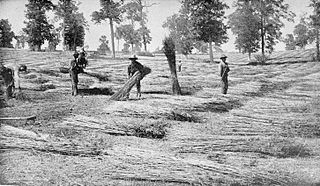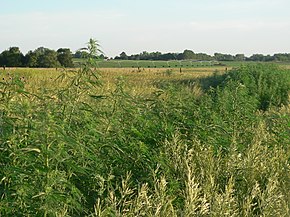
The Marihuana Tax Act of 1937, Pub. L. 75–238, 50 Stat. 551, enacted August 2, 1937, was a United States Act that placed a tax on the sale of cannabis. The H.R. 6385 act was drafted by Harry Anslinger and introduced by Rep. Robert L. Doughton of North Carolina, on April 14, 1937. The Seventy-fifth United States Congress held hearings on April 27, 28, 29th, 30th, and May 4, 1937. Upon the congressional hearings confirmation, the H.R. 6385 act was redrafted as H.R. 6906 and introduced with House Report 792. The Act is now commonly referred to, using the modern spelling, as the 1937 Marijuana Tax Act. This act was overturned in 1969 in Leary v. United States, and was repealed by Congress the next year.

Hemp, or industrial hemp, is a botanical class of Cannabis sativa cultivars grown specifically for industrial or medicinal use. It can be used to make a wide range of products. Along with bamboo, hemp is among the fastest growing plants on Earth. It was also one of the first plants to be spun into usable fiber 50,000 years ago. It can be refined into a variety of commercial items, including paper, rope, textiles, clothing, biodegradable plastics, paint, insulation, biofuel, food, and animal feed.

The Hunter Valley cannabis outbreak was an infestation of the marijuana plant, Cannabis sativa in the Hunter Valley in New South Wales, Australia. At its peak, the infestation covered about 30 square kilometres (12 sq mi). It took nine years for the New South Wales government to eradicate it.

In the United States, increased restrictions and labeling of cannabis as a poison began in many states from 1906 onward, and outright prohibitions began in the 1920s. By the mid-1930s cannabis was regulated as a drug in every state, including 35 states that adopted the Uniform State Narcotic Drug Act. The first national regulation was the Marihuana Tax Act of 1937.

Cannabis strains are either pure or hybrid varieties of the plant genus Cannabis, which encompasses the species C. sativa, C. indica, and C. ruderalis.

The use, sale, and possession of cannabis over 0.3% THC in the United States, despite laws in many states permitting it under various circumstances, is illegal under federal law. As a Schedule I drug under the federal Controlled Substances Act (CSA) of 1970, cannabis over 0.3% THC is considered to have "no accepted medical use" and have a high potential for abuse and physical or psychological dependence. Cannabis use is illegal for any reason, with the exception of FDA-approved research programs. However, individual states have enacted legislation permitting exemptions for various uses, including medical, industrial, and recreational use.

Cannabis in Nebraska is fully illegal, but first offense for possession of small amounts was reduced to a civil infraction in 1979.

Cannabis in Iowa is illegal for recreational use if classified as marijuana but consumable hemp products including CBD products are legal for consumers to possess and registered retailers to sell. Possession of even small amounts of marijuana is a misdemeanor crime. The state has a medical program for patients with qualifying debilitating medical conditions that allows for the legal sale and possession of no more than 4.5g of THC per patient every 90-day period. Allowed modes of consumption are oral & topical forms including, but not limited to; tablets and tinctures, nebulizable inhalable forms, suppositories, and vaporization.

Cannabis in Kentucky is illegal for recreational use, and legal for medical use under executive order, with full medical legalization statute taking effect in 2025. Non-psychoactive CBD oil is also legal in the state, and Kentucky has a lengthy history of cultivating industrial hemp for fiber since 1775.

Kentucky was the greatest producer of hemp in the United States during the 19th and 20th centuries, when it was the source of three fourths of U.S. hemp fiber. Production started to decline after World War I due to the rise of tobacco as the cash crop in Kentucky and the foreign competition of hemp fibers and finished products. In 1970, federal policies virtually banned the production of industrial hemp during the War on Drugs saying all Cannabis sativa is a Schedule I controlled substance. Federal law under the Agricultural Act of 2014 allowed research back into hemp. Kentucky began production again with 33 acres in 2014. As of the 2016 harvest season, only two U.S. states other than Kentucky had over 100 acres (40 ha) in hemp production: Colorado and Tennessee. The first 500-acre commercial crop was planted in Harrison County in 2017, and research permits were issued for over 12,000 acres (4,900 ha) that year. The 2016 documentary Harvesting Liberty concerns the 21st century Kentucky hemp industry.
The legal status of cannabis in North Korea is unclear due to the lack of sources available to the outside world. Marijuana, along with most drugs, are listed as controlled substances under the penal code of North Korea. Cannabis for industrial purposes (hemp), which has a low THC, is legal and is widely used in the country for the production of consumer goods. As a result of the lack of reliable information on North Korea, myths suggesting the legal or widespread use of marijuana have been spread by some media outlets.

Cannabis has been cultivated in Japan since the Jōmon period of Japanese prehistory approximately six to ten thousand years ago. As one of the earliest cultivated plants in Japan, cannabis hemp was an important source of plant fiber used to produce clothing, cordage, and items for Shinto rituals, among numerous other uses. Hemp remained ubiquitous for its fabric and as a foodstuff for much of Japanese history, before cotton emerged as the country's primary fiber crop amid industrialization during the Meiji period. Following the conclusion of the Second World War and subsequent occupation of Japan, a prohibition on cannabis possession and production was enacted with the passing of the Cannabis Control Law.

Cannabis in Russia is illegal. Possession of up to 6 grams is an administrative offense, punishable by a fine or detention of 15 days. Possession of larger amounts is a criminal offense.

Terms related to cannabis include:

Cannabis in Alberta became legalized on October 17, 2018 following the coming into force of federal Bill C-45. Production, distribution and consumption of cannabis had been prohibited in Canada since 1923. While some other provinces distribute cannabis through publicly owned retail monopolies, Alberta allows private companies to sell cannabis at licensed retail storefronts and online. Private retailers must purchase cannabis from the provincial wholesaler, the AGLC. Originally, the Alberta government was the sole entity permitted to retail cannabis online within the province but as of March 8, 2022, private retailers are permitted to do so and the province has since exited the retail business.

Hemp in the United States was a legal crop in the 18th and 19th centuries. Production was effectively banned in the mid-20th century, but it returned as a legal crop in the 21st century. By 2019, the United States had become the world's third largest producer of hemp, behind China and Canada.








